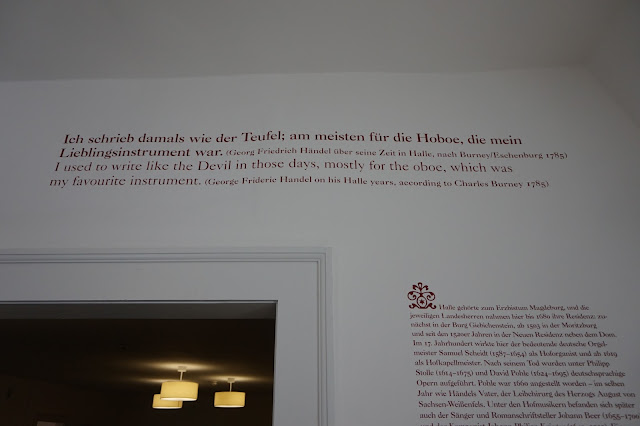The house is quite large and encompasses not only the building you see on the corner below but also the one with the steep roof next to it. This is the house in which Handel was born and is where he spent the first 18 years of his life.
Though I adore Messiah to the point of near obsession, I didn't think I'd necessarily spend a whole lot of time in this museum dedicated to its composer - was figuring half an hour to forty-five minutes. I'm not sure how long I spent here, but it was quite a bit longer than that. The museum is so large and well presented, and the descriptions of the displays were so interesting; I think I read every single thing that was posted. The room shown below shows a map of the city streets and also buildings that were significant in Handel's life - such as his home, the Market Church, the cathedral, and so on.
Many descriptions and quotations were painted right on the walls. I don't know that I'd seen that done before, but it worked well. Some of the larger signs were words of his friends or admirers. I especially like the one from Beethoven (two pictures down).
Another wall painting was this map of where Handel had lived. I had no idea he'd lived so many places! Next to this on the wall was a timeline of his life and when it was he had been in each place, for what reasons he had moved, etc.It's interesting how the next image resonated with me as being similar to childhood stories of some of the mathematicians I've been studying. Apparently Handel's father had forbidden him to pursue music, which had become an "absorbing passion" for him. For a time the family thought their house was haunted, as they were hearing sounds coming from the attic, but a trip up there one night found Handel playing under cover of darkness.
Handel was born on February 23, 1695 and was baptized the next day in the Marienkirche (also known as the Marktkirche or Market Church). The church and baptismal font are pictured below.
The church is the four-towered structure in the center of the picture, and the statue in the foreground is of Handel. For more pictures of the church (inside and out, above and below), click here.
According to one of the wall displays in the museum, Handel "had his first and only musical education from Fredrich Wilhelm Zachow (1663-1712), the organist of [this] church. The small organ above the altar, built by Georg Reichel in 1664, was available to the boy from the beginning. He would have seen the large organ [at the back of the church], built by Christoph Cunzius and whose original outer case is still visible today, only on his later visits to Halle. None other than Johann Sebastian Bach wrote a report on this organ in 1716; between 1746 and 1764 his eldest son, Wilhelm Friedemann Bach (1710-1784) was organist here . . ."
Halle Cathedral (or "Dom") is pictured below - as seen from the top of the Marienkirche. Handel was hired to be organist here in 1702. In 1688 the church had been handed over to the newly-arrived Calvinists as their parish church. Handel was Lutheran, so he was appointed to a one-year probationary term only. Since the Calvinist worship was relatively limited musically, Handel had to restrict himself, though on feast days he probably had a choir available to him from the local reformed grammar school.
It was interesting to me to read of worship music concerns of the day. As they say, "The more things change, the more they remain the same!" Below is a picture of a "Cheerful Hymn-book" that Handel would have been familiar with. The picture below that expresses the concern of orthodox Lutheran theologians of the "deeply subjective piety" of the texts and the "cheerful worldliness of its melodies." |
| Glass Harmonica |
 |
| "Harmonium" - I never knew it was called that; my parents have one, and I've always called it a "pump organ." |
And I can't finish without including the following products of Halle's chocolate factory (the oldest in Germany), the Halloren Schokoladenfabrik.
(The white bits on the chocolate are salt, which Halle/Saale is also famous for and is named for!)















































